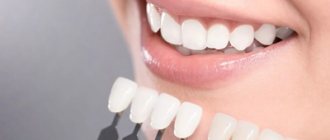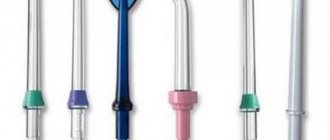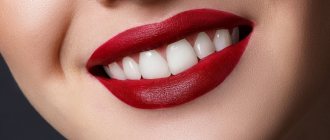A beautiful smile is a person’s calling card. The condition of your teeth affects not only your physical but also your mental health. It is also an indicator of success.
Previously, dentistry used dental crowns to restore even slightly damaged teeth. To do this, they had to sacrifice their natural teeth and subject them to severe grinding. Or remove the coronal part completely.
Now technologies make it possible to eliminate defects on the surface of the tooth, practically without processing it. For this, ultra-thin plates are used that are fixed on the outside of the tooth - veneers. The most popular of them are ceramic veneers, which have a high degree of aesthetics.
What it is?
Despite their ultra-thinness, the strength of the plates is comparable to the hardness of natural tooth enamel. The material allows you to repeat the shape of the tooth with maximum accuracy, hiding visible defects on its surface.
The demand for ceramic veneers is due to their practicality and full compatibility with the human body. The pads are non-toxic, do not cause allergic reactions, and do not require addiction. The translucent material is identical to natural tooth enamel. The shade scale allows you to select the color of the veneers that is similar to the shade of the patient’s teeth.
There are no problems with installing veneers: the plates are attached to the outside of the tooth using a dental compound.
How is a ceramic veneer different from a lumineer?
Ceramic veneers and lumineers are not the same thing. Lumineers are also dental coverings, only:
• veneers are thicker, so you have to grind off the enamel layer before installing them. In addition, at the junction of the gum and the attachment of the plate, after a while a small space may form where food debris will accumulate; • the warranty period for veneers is shorter; • veneers are cheaper than lumineers.
Lumineers have recently appeared. People often call them “Hollywood”, as they help create the snow-white smile of celebrities.
pros
Fixing veneers is the fastest and most painless way to restore the aesthetics of teeth. Yes, the teeth are pre-treated. However, turning is no more than 0.5 mm.
The minimum duration of the procedure is associated not only with the immediate installation of veneers, but also with the number of visits to the dentist. If the patient does not require pre-treatment, the entire process will require no more than 3 visits to the doctor.
Important: you should not trust advertising that promises a Hollywood smile using veneers in one session. The plates are made in a dental laboratory based on previously taken impressions of the patient’s jaw. The work is complex, requiring extreme concentration and high professionalism. Therefore, it is impossible to create ceramic veneers in an hour or even in 2 hours.
Some methods of prosthetics require a long period of getting used to new teeth. Overlays do not fall into this category. After fixing microprostheses, unusual sensations may occur due to the appearance of a foreign structure in the oral cavity. But in just a day or two, the discomfort will disappear. Ceramic veneers do not affect the patient’s usual lifestyle, eating and diction.
Long service life is one of the main advantages of the plates. On average, veneers “live” for at least 15-20 years. When used correctly, of course. In addition, microprostheses can be installed in patients with high sensitivity - rejection and allergic reactions are excluded.
How much do veneers cost?
In each case, the cost of treatment will be different. This depends on the number of plates, the material of manufacture, and preliminary manipulations. Prices for porcelain veneers per tooth may seem high if you do not take into account the following factors:
- Service life of linings. Change composite veneers every 5 years, crowns every 7 years, or install veneers and forget about them.
- Possibility to pay in installments or through credit. Clinics often offer such options. For example, at the ROOTT MCDI in Moscow, loans and installments can be issued directly at the clinic.
- Possibility to reduce the cost during discounts and promotions. When making a decision about microdental prosthetics, we recommend studying reviews from patients who have already undergone such procedures. By comparing “before and after” photos, you can draw a conclusion about what results you should expect from installing veneers.
Disadvantages of the design
The main disadvantage of veneers is the price. For this reason, the procedure is not available to everyone. If we are talking about a minor flaw, then you can choose a more budget option - composite veneers. The material is applied directly to the tooth surface. And under the influence of the light flux, it gradually, layer by layer, hardens, forming a plate.
If the problem is related to darkening of the enamel, you can use a professional whitening procedure. The service is less expensive, but no less effective.
Another disadvantage of plates is the grinding of teeth. No matter what thin ceramic veneers are used, it will not be possible to simply remove the structure from the teeth. You will need to install a new onlay or crown.
Aspects of Shade Determination
To select a shade of products that would look natural with all teeth and harmonize with them, dentists advise determining the color of dental units in three directions - in the cervical, incisal-occlusal, and middle parts separately.
Important! Anatomical organs along their length have a non-uniform surface shade, i.e. their color changes from tip to gum. The shade is also influenced by the health and condition of not only the teeth, but also the gum tissue and the thickness of the enamel coating.
In the process of choosing a color, experts are always guided by the following rules:
- The true color of teeth should only be determined in daylight (when the intensity does not exceed 1.5 thousand lux). Any artificial color has a dominant shade in its spectrum, which is associated and determined by the origin of the material itself.
Neglecting this rule can lead to inaccuracy in determining the category of hue and determining its saturation. In large dental centers, installations that reproduce sunlight are used for this purpose.The advantage of such devices is the ability to regulate the intensity of the lighting supply, as a result of which it is possible to create conditions that are as close as possible to the best for specifying the shade of dental units.
- White color, as you know, reflects more than it absorbs , as a result of which in the interior of offices where the determination and selection of shades takes place, there should be no “flashy” tones, which means that all surfaces of the office should be covered in calm and light colors.
- or its individual accessories, and even doctor’s gloves, can also distort this process Any “distracting” element on the patient’s face and clothing can greatly affect the perception of color and distort the result.
- An important role in determining the color of dental units is played by the degree of their moisture. Thus, an absolutely dry enamel coating and a highly moistened one have different reflective properties.
The specialist must also take into account such small details as the intensity of makeup, the tone of the client’s lipstick, eye color and white tint, hair and skin color. - Not least important for the correct perception and determination of the color of dental elements is the emotional state, and even the mood of the patient. Before the procedure, it is important for the specialist to create a friendly and comfortable atmosphere when communicating with the client.
This is interesting: What types of dentures are there in the absence of teeth: the best options for jaw prosthetics
After completing all the rules, the dentist begins the procedure for determining the color - first, through selection, he compares the color of the client’s teeth with the attached scale sample, and then the color is determined by saturation.
Preparing for a Smile Appearance Assessment
Before comparing enamel with the Vita palette, the patient must thoroughly clean his teeth of plaque and stone. However, more often than not this is not enough. Therefore, it is necessary to additionally carry out professional cleaning of dental plaque to restore the natural shade.
Before assessing the color, you need to have your teeth professionally cleaned.
Why high technology doesn't always help
You can often read negative comments on forums that computer technology is not used to determine tone. And although there are programs developed specifically for such a procedure, the most accurate is still a visual comparison of the patient’s crowns with the base table.
Interesting to know! An adequate assessment of color by a computer is influenced by many factors: the lighting in which the image loaded into the program was taken, the resolution and color sensitivity of the camera used to take the image, and the color calibration of the computer itself. And even if at some point there was a failure of a tenth of a percent, this may affect the final result, and the sample selected by the computer will turn out to be lighter or darker than necessary.
In addition, using programs to determine the color of crowns is more expensive than using the basic Vita table, which is why doctors most often resort to this method, especially in small dental offices. And it’s more convenient for patients to compare samples in person.
What conditions are necessary for high-quality diagnostics?
Despite the fact that using the Vita scale is cheaper and gives more accurate results, it is important to observe certain conditions when testing:
- Before testing, you need to brush your teeth twice: once at home, immediately before the appointment, and the second time the doctor cleans it using special solutions. This is necessary in order to remove microplaque that forms daily on the enamel and can affect its color,
- It is recommended that the patient come to the appointment wearing clothes in neutral pastel colors and with an open neck so that the fabric does not contrast with the face and teeth. If a person wears white, black or other bright clothing, this may distort the doctor's perception,
- In the dentist’s office, it is important to create high-quality lighting: if testing takes place in the dark, dentists use powerful lamps or special frames with LEDs to simulate daylight, which are held by the doctor’s assistant or the patient himself during testing. For the accuracy of the procedure, it is important to fully illuminate all crowns,
- the patient must be healthy: the choice of color tone according to the Vita scale, as a rule, is carried out only on healthy units of the dentition and in the absence of any chronic acute diseases in the patient. This is done because any serious disease of organs and systems can affect the natural color of crowns,
- if the patient has teeth with different shades of enamel: here the doctor often recommends an intermediate shade or a decision is made to correct not just one tooth, but the entire smile area.
In what cases are plates installed?
The main purpose of onlays is to eliminate aesthetic defects on the front teeth. It can be:
- Chips and cracks.
- Previously installed fillings that have changed color or cracked.
- Interdental gaps and tooth pigmentation that cannot be eliminated by professional cleaning.
- Pathological abrasion of enamel.
In addition, ceramic veneers help correct minor changes in the bite, crooked teeth, and a decrease in the volume of gum tissue.
Veneers: pros and cons
The greatest difficulty for dental patients arises when choosing between installing crowns or veneers. If a specialist has not identified any contraindications for you to install veneers, then it is better to give them preference. When contraindications are still present, stop at crowns. Minor crooked teeth can be corrected with braces.
What is better - veneer or crown?
What are the differences between crowns and veneers? To install a crown, teeth are sharpened on all sides, removing up to 2 mm of enamel. The prepared tooth will resemble a small stump. Attaching a veneer requires processing only the front surface of the tooth, and the specialist removes a much thinner layer of enamel.
What is better: veneers or restoration?
Among the characteristic qualities of porcelain veneers, one can note their unique ability to create an imitation of the natural tissues of human teeth. Porcelain has a structure very similar to tooth enamel, which allows you to achieve excellent results. The specialist gives the veneer the required translucency. The material will reflect light just like a real human tooth.
The performance of light-polymer filling compounds cannot be compared with the performance of porcelain veneers. The restoration composition will not be so noticeable under braces, but it cannot fully perform the function of veneers. It does not have the required translucency and is extremely limited in color palette. Filled front teeth have poor aesthetics due to all of the above.
The restoration tends to darken as it wears, so fillings must be changed regularly. Often, a darkened border appears on the border between healthy tooth enamel and the filling compound, which causes a lot of discomfort to the patient. Porcelain veneer will not lose its color and transparency for several decades.
Which is better: braces or veneers?
This example shows a patient who chose veneers over braces. Photos before and after
To make a choice between veneers and braces, it is necessary to assess the degree of deformation of the teeth and disruption of their normal position. Veneers can only deal with minimal defects. Braces will help to refrain from grinding down the healthy enamel of a number of teeth and will restore the normal position of the incisors with minimal loss.
The concept of high technology can be applied to modern braces. Such braces can eliminate traces of slight crowding of teeth for six months. It takes up to one and a half years to get rid of complex disorders. In addition to standard metal braces, Moscow dentists also offer invisible models made of transparent sapphire.
Those clinic patients for whom it is important to eliminate minor dental defects in a short period of time, not exceeding three weeks, refuse to install veneers instead of braces. We hope you found answers to your questions in our article and learned a lot about dental veneers and their main differences from other methods of eliminating aesthetic dental defects.
Contraindications
Despite the versatility and practicality of the technique, there are limitations to the installation of veneers. For example, the use of plates is contraindicated in cases of bruxism, the presence of inflammatory processes, bone tissue pathology, and malocclusion.
Also, ceramic veneers are not used for the restoration of severely damaged teeth (more than 50%). In this case, the doctor installs crowns.
A refusal to carry out the procedure may be the presence of bad habits (biting nuts, nails, opening bottles with teeth, etc.). Or a high risk of maxillofacial injury. For example, extreme sports.
Gum disease and loss of chewing teeth will also require preliminary treatment before installing plates.
Veneers are ideal in the following situations:
- when the crowns of the front teeth do not have a beautiful shape, have an incorrect slope or occupy an uneven position in the dentition,
- when there are fillings on the front surface of the front teeth that are visible,
- when you need to quickly correct slight crowding of teeth,
- when you need to quickly correct wide gaps between teeth,
- unsightly tooth color that cannot be corrected, for example, using chemical whitening techniques.
Veneers, which have first-class aesthetics and can last from 12 to 25 years (without darkening or changing their color), are made only from ceramics. In economy class and mid-price clinics, the cost of such veneers starts from 25,000 rubles and can reach 50,000 rubles (for 1 unit). And for composite veneers, which have a much more modest aesthetic, the price will be only 8,000 rubles. See detailed price list for veneers below.
Production technology
Ceramic veneers are usually made using three techniques:
- Applying the composition to a plaster model followed by heat treatment. The dental technician evenly distributes the composition over the surface of a special material that holds the paste during firing. The technique is inexpensive and allows reducing shrinkage of the structure.
- Casting. In this case, a model of future ceramic veneers is first created using wax. Then it is fixed in a refractory mass and installed in the sprue. Processing is carried out under high temperature. At the final stage, the dental technician paints the plates in a color that matches the patient’s tooth enamel.
- Pressing (Emax). More modern technology that reduces the porosity of the material. This ensures maximum structural strength. As a result, pressed plates have a longer service life. After processing, ceramic veneers are coated with a special compound that adds shine to the overlays.
Recently, the digital method of making veneers using a milling cutter has become popular. The model for the plates is obtained using a non-contact scan of the patient's oral cavity. A computer program calculates the structure. The sample is then sent for milling. The advantages of the method are obvious: the automated process eliminates possible inaccuracies and errors in the production of microprostheses.
Manufacturing and installation
Ceramic veneers are installed after successive stages of work by a doctor at the ROCOSCLINIC clinic.
1. Consultation - a specialist finds out what aesthetic problems concern the client. The bite, defects, and enamel shade are taken into account. 2. The technician performs virtual modeling of teeth using a computer program. With the help of simple manipulations, thanks to mock-up technology, the formed volume of teeth helps to create temporary plastic structures. 3. Fitting, approval of the shape and color of the crown of the teeth. 4. Fixation of permanent ceramic restorations using a microscope ensures high precision.
Products are manufactured in our dental laboratory.
Diagnostics
The fixation of ceramic plates is carried out in three stages: preparation for the installation of veneers, production of the structure and fixation on the teeth.
Correctly performed diagnostics determines how long the orthopedic structure will serve the patient. In addition to the condition of the teeth, it is important to identify possible hidden pathologies in the bone and soft tissues of the jaw. And also carefully study the anatomical structure of the teeth being restored.
At EspaDent clinics, specialists conduct radiographic examinations for more accurate diagnosis. In complex cases, a modern 3D tomograph is used, which creates three-dimensional, layer-by-layer images of both jaws. During a consultation in our clinics, the doctor will offer the best options for microprostheses and immediately indicate the cost of the procedure.
Rules and conditions for determining tooth color
The color of the tooth is determined at three points: in the middle part of the tooth, in the cervical and incisal-occlusal parts. This is necessary to create a natural color effect, since the surface of the tooth enamel in different areas of the tooth has a different shade. The condition of the gums, the tooth itself, and the thickness of the tooth enamel are involved in the manifestation of the difference in shades on the surface of the tooth.
To optimally select veneers based on tooth color, the following conditions must be met:
- The color of teeth is determined only in daylight. Any artificial lighting has a predominant shade in its spectrum, which is associated with the nature of the specific material that emits this light. In this case, the illumination intensity should not exceed 1500 lux. Neglecting the last requirement may cause an error in determining the desired brightness of the hue. Some dental offices use installations that simulate light from the solar spectrum. The advantage of such installations is that they are adjustable in light intensity, which allows you to create conditions close to ideal for determining the shade and its brightness.
- White color is more reflective than absorbing, therefore, to determine the most suitable shade, you need to take into account that the office in which the color selection is carried out does not include an interior of “screaming” tones, the walls are painted in even light colors. Clothing, its accessories, and dentist’s gloves can also distort perception when choosing a shade. If you need to achieve quality when choosing a color, you need to take into account any little thing that can distort the natural shade.
- Moisture levels also play an important role in determining the color of teeth. Dry enamel has a completely different reflective ability than moistened one. In addition, you need to take into account details such as the patient's makeup and lipstick. Of course, any “extra” paint on the patient’s face can greatly distort the correct perception of color.
- Some dentists also believe that the natural perception of tooth color is influenced not only by external factors, but also by the emotional state of the patient, so you need to worry in advance about a comfortable, friendly environment when communicating between the dentist and the patient.
After the conditions for optimal determination of the color of the teeth have been met, the dentist performs a simple color selection procedure: the first stage, by comparison with the applied scale standards, is the shade selected, and then, when the shade is selected, the brightness is determined.
Installation steps
If the patient does not require preliminary treatment, the next step is professional oral hygiene. The dentist removes hard and soft plaque from the teeth and disinfects the oral cavity. Before treating the teeth, the specialist selects the color of future ceramic veneers according to the Vita shade scale. Grinding of teeth is carried out in a gentle manner, without pain. If necessary, safe local anesthesia is used.
Next, the doctor proceeds to taking impressions of the teeth. According to the chosen method, first a model of the plates is made, and then the final microprosthesis. On average, the production of ceramic veneers takes 1-2 weeks, depending on the complexity of the design.
While the patient waits for new veneers, temporary plastic or composite veneers are fixed to the treated teeth. Onlays protect your natural teeth from bacteria. They also provide chewing function before the installation of microprostheses.
After the plates are ready, the doctor fixes them on the teeth one by one. Each dental unit requires approximately 30-60 minutes.
How is the color of veneers determined?
To select the color of ceramic microprostheses, dentists use a special scale called Vita. It includes:
- 16 natural shades;
- 4 ultra-whites that practically do not exist in nature - Bleach.
Thus, you can choose the appropriate color from as many as 20 options. If the patient only needs a few restorations, the shade of the veneers should match the color of the adjacent teeth. However, if microprostheses are placed over the entire smile area, then the patient is free to choose any color he likes, based on his ideas about beauty and the doctor’s recommendations.
Naturally colored veneers according to the Vita scale are presented in the form of four blocks in accordance with the enamel undertone:
- A - red-brown;
- B - yellow-red;
- C - gray;
- D - gray-red.
There is no need to be alarmed: such a classification does not mean that the selected sample will be red or gray. Only a specialist will see the difference between the tone of ceramic veneers; for patients, they look approximately the same - like ordinary natural teeth.
Each of the four blocks contains four shades, grouped by brightness: from the lightest to the darkest. They are designated by the numbers 1, 2, 3 and 4. Accordingly, all tooth colors on the Vita scale have their own alphabetic and digital number - for example, a2 or b1.
Types of veneers
Microprostheses are distinguished by the type of material used in their manufacture. Ceramic veneers, without impurities, are considered traditional. For example, porcelain or pressed ceramics. The advantage of these plates is their impeccable aesthetics. The veneers look natural and neat on the teeth. But ceramics are far from the most durable material. It is not able to withstand significant chewing load.
To increase strength, dentistry has developed zirconium dioxide veneers. In this case, the microprosthesis consists of two layers: a zirconium base and a ceramic lining. Dental crowns are made using the same principle. Important: these plates are metal-free. It is not zirconium (metal) that is used here, but zircon, a natural white mineral. The stone has increased hardness, which allows it to be used to restore lateral teeth. However, the aesthetics of zirconium plates are far from perfect, so after production, an additional layer of ceramic is applied to the veneers. The result is durable ceramic veneers with enamel identical to natural teeth.
The third group includes lumineers - ultra-thin plates. The thickness of the onlays does not exceed 0.2-0.3 mm, which minimizes the process of grinding the teeth. The use of lumineers allows you to hide flaws in the dentition, while preserving the enamel of your natural teeth. The minimum thickness does not affect the functionality of microprostheses in any way. The plates can withstand full chewing load, without chips or cracks. However, there is also a downside: the manufacture and installation of ultra-thin veneers is similar in complexity to jewelry work. High qualifications of both the dental technician and the dentist are required. Which leads to an increase in the cost of the procedure. The cost of making lumineers can be 3-4 times higher than traditional porcelain veneers.
Ceramic veneers. Solid ceramic. E.Max.
Ceramic veneers are thin plates of ceramic that the dentist glues to the outer surface of the tooth to change the appearance of the tooth, its shape and color.
All-ceramic crowns are crowns on teeth made only from ceramics, without the use of other materials.
On the one hand, I am FOR ceramic veneers, as they transform and rejuvenate smiles.
On the other hand, I am AGAINST ceramic veneers, since they require grinding of the teeth. Yes, minimal, but still, grinding! It’s one thing if veneers are made according to indications, for example, teeth that are very discolored (the reasons for this can be different), the shape or position of the teeth are not aesthetically pleasing, trauma, etc. But in the pursuit of beauty and profit, they are used to burr and mercilessly grind down absolutely healthy teeth. teeth. Patients want it - the doctor doesn’t mind making money!
I would like to draw your attention to several serious points if you have decided to make yourself ceramic veneers. Yes, by the way, the material for veneers is solid ceramics, E.Max is sometimes called, but I won’t go into details about this now.
So, first, there are indications and contraindications for veneers, and your dentist should conduct a thorough study of the condition of the dental system before offering you veneers. Otherwise, your veneers will chip.
Secondly, grinding for veneers is carried out within the enamel of the tooth. If you remove almost all the enamel, the strength of the veneer’s adhesion to the tooth decreases significantly, and it also comes off. Such precise preparation is only possible under a microscope or with special optics.
Third, the veneers are fixed using an adhesive protocol with mandatory isolation of each tooth with a rubber dam. If you don’t do this, you won’t be able to properly clean your teeth before bonding and create absolute dryness of the bonded surfaces, and the veneer will come off. Not only the tooth is subjected to multi-stage processing (sandblasting, etching, conditioning, bonding) but also the veneer itself. It needs to be etched with hydrofluoric acid, then phosphoric acid, then kept in an ultrasonic bath with alcohol, then applied with silane, and only after all this cement and placed on the tooth.
Fourth, the veneer covers only the outer, visible part of the tooth. The surface of the teeth that faces the palate and tongue in these cases remains unchanged. And if you open your mouth wide, everyone will see what color your real teeth are, keep this in mind.
If you also cover the inner surface of the teeth with ceramics, it is already a ceramic crown, and not a ceramic veneer at all. Sometimes such a crown is slyly called a FULL VENEER, but it is a crown and nothing else.
These are just some of the nuances. This also includes the hands of a technician. It is the skill of the dental technician that determines how your ceramic veneers look. Agree, not everyone can make a translucent shell with the ideal shape and color for you, with a thickness of 0.1 to 0.5 mm.
Based on all this, the conclusion is that a high-quality ceramic veneer, an all-ceramic veneer (crown) will not be cheap.
Below I will give an example of the production of all-ceramic crowns for total prosthetics. Technically, in such a situation, nothing prevents you from making veneers, BUT after diagnosis and the wishes of the patient, it was decided to cover all the teeth with all-ceramic crowns (full veneers) so that the teeth were white on all sides.
So, the initial situation: partial absence of teeth, incorrect position and shape of teeth, abrasion.
At the diagnostic stage, wax modeling was carried out, and a decision was made to restore the missing teeth in the lower jaw with implants. Teeth on the upper jaw 1.7, 1.6 and 2.7 are not affected, since they are not visible when smiling and do not interfere with functionality.After integrating the implants and modeling the gums with temporary crowns, a circumferential preparation of the upper and lower teeth was carried out. The reduction (grinding down) of hard dental tissues was 0.5 – 1 mm depending on the area. Before the impression, the gums were retracted (moved away) using threads. Impression copings are installed on the implants. Implants – Straumann Bone level.
Orthopedist: Karneev Andrey Nikolaevich
Orthopedist: Karneev Andrey Nikolaevich
The laboratory produced all-ceramic (e.max) crowns for the teeth of the upper and lower jaws. The crowns were so thin and elegant that they were translucent.
Individual zirconium abutments are made for the implants, and they have the same all-ceramic crowns. (photo below).
As I described above, the technology for fixing solid ceramics is adhesive and includes many steps. Below in the photo you see the etching of crowns with hydrofluoric and phosphoric acid.
Since there are a lot of crowns, to speed up the whole process they are collected into blocks and processed at once.
Isolation of the working area with a rubber dam is a must!
Orthopedist: Karneev Andrey Nikolaevich
The process of fixing all-ceramic crowns to teeth, like veneers, is very labor-intensive and can take an entire working day. This requires tremendous endurance from the doctor and incredible patience from the patient. Look at the finished result (photo below). With proper care, these crowns can last a lifetime.
Orthopedist: Karneev Andrey Nikolaevich
Orthopedist: Karneev Andrey Nikolaevich.
Examples of my work HERE
Budget analogue - composite veneers
There is an easier and faster way to restore teeth. Composite veneers help with this - a polymer in the form of a paste that is applied directly to the surface of the tooth. The composition is mixed in the dentist's office, which allows you to complete the procedure in one visit. Of course, if there is no need for preliminary treatment of teeth and soft tissues.
The composite has good aesthetics and does not require significant grinding of natural teeth. Hardening is carried out layer by layer, under the influence of light flux. This provides the necessary strength to microprostheses. The technique is suitable for restoring lateral teeth.
Disadvantages of polymer restoration:
- Shorter service life compared to ceramic veneers - no more than 5-6 years.
- Instability to pigmentation. The material changes color over time and absorbs coloring components.
- Imperfect match to the shade of natural enamel.
Differences between composite and ceramic veneers
| Composite | Ceramics |
| Changes color | Long lasting color |
| Loses its shine | Stable shine |
| Needs polishing regularly | Does not require special care |
| Low cost | High price |
| Produced on site, during reception | Made from casts in the laboratory |
Yes, the cost of ceramic veneers is higher than that of composite ones. But their service life is much longer, they do not need to be polished regularly and their aesthetic appearance remains unchanged. It is worth considering all the factors before choosing a material for veneers.
Manufacturers
To protect yourself from low-quality prosthetics, check with the clinic about what materials are used in the procedure. Mainly large companies specialize in the production of ceramic veneers. There aren't many of them.
The most famous company Nobel Biocare is a leader in implantology and prosthetics. It was this manufacturer that developed the popular protocols for implantation procedures All-on-4, All-on-6, Trefoil, etc. In the case of installing veneers, the company specializes in the production of zirconium plates.
The list includes German and Japanese companies that produce their products under the brands Katana, Prettau and BruxZir Anterior. The leader in the production of pressed and solid ceramics is Ivoclar Vivadent, which specializes in Emax technology.
Many years of experience, modern materials and strict quality control allow these companies to occupy a strong position in the dental materials market.
Price issue
The cost of ceramic veneers is influenced by the material, installation method, and complexity of the procedure. As well as the qualifications of the doctor and the reputation of the clinic. On average, prices for pressed ceramics start at 23 thousand rubles. Zirconium ones will cost 35 thousand and more, composite ones - from 10 thousand rubles.
If after diagnosis the patient needs dental treatment, the final cost will be higher.
At EspaDent clinics, the patient learns the final amount immediately after the initial diagnosis. No surcharges or hidden fees. For expensive procedures, our patients have the option of interest-free installments. Diagnostics and initial examination in all EspaDent clinics are free of charge.
Prices
Free online consultation with a dentist
| Service | Price |
| Installation of ceramic veneer E-max | from 28,000 rub. from 37,000 rub. promotion |
| Installation of ultra-thin ceramic veneer E-max | from 55,000 rub. |
| Installation of ultra-thin ceramic veneer SHOFU (Japan) | from 60,000 rub. |
Consultation and diagnostics are free!
All prices Promotions
Care instructions
After dental restoration, you want microprostheses to last as long as possible. This is a completely doable task if you follow the recommendations for caring for ceramic veneers. There are no complicated regulations. The rules are the same as for preserving natural enamel:
- Daily oral hygiene. Use a medium-hard toothbrush and a toothpaste without abrasive particles (not whitening).
- To clean the interdental spaces, it is recommended to use dental floss and rinse your mouth after eating.
- Do not eat too hard foods. Avoid sudden changes in temperature (very hot and cold food).
It is also important to visit the dentist 1-2 times a year for a preventive examination and professional oral hygiene.
In the first days after installation of veneers, unusual sensations may occur due to the appearance of foreign material in the mouth. Especially if the teeth have changed length after prosthetics. But the discomfort will disappear after 1-2 days.
Advantages and disadvantages
Veneers can be used to correct many different defects. You can make your teeth perfect, change an unattractive shape, eliminate wide gaps, and restore enamel that is not amenable to chemical whitening. At the same time, veneers will not make teeth stronger, but will only change their appearance. If not properly cared for, veneers can peel off, crack, and break. The cost of the veneers procedure is much higher than the whitening procedure.
If you already know what you want and have decided to install veneers, then give preference to trusted dental centers. One of them is the German Center for Aesthetic Dentistry SDent. This is the only way you can get a perfect snow-white Hollywood smile in the shortest possible time.
Startsmile experts are leading dentists in Moscow. Doctors at our aesthetic dentistry center SDent are among the leading specialists in the field of dentistry throughout Moscow.
More details
We will install high-quality ceramic veneers on the lower, upper or both jaws. We will not only install high-quality veneers, but also tell you how to properly care for them.









